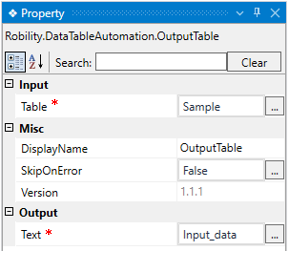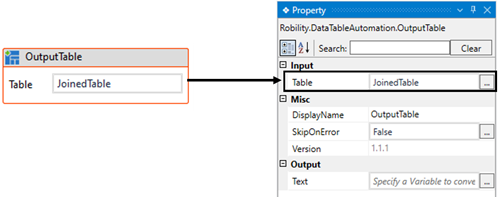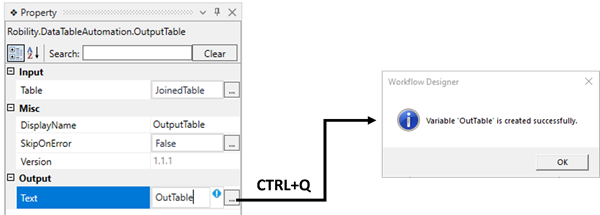This activity helps the user to convert the “Datatable” into “String” datatype.
Technical Reference
|
INPUT |
Table: Enter the "Input datatable" variable where the input data is stored. This parameter helps you to convert the “datatable” to “String”. This field only accepts the "datatable" data type. |
|
|
MISC |
DisplayName: Displays the name of the activity. The activity name can also be customized to help in troubleshooting. |
|
|
SkipOnError: It specifies whether to continue executing the workflow even if it throws an error. This supports only Boolean value “True or False”. By default, it is set to “False.” True: Continues the workflow to the next step None: If the option is specified as blank, by default the activity will perform as “False” action. |
||
|
Version: It specifies the version of the Datatable automation feature in use |
||
|
OUTPUT |
Text: It helps to view the output of the activity as the converted table in the “String” format. (Refer the steps below to create a variable). |
* Represents mandatory fields to execute the workflow.
Here's an example of how the OutputTable activity works –
In the following example, I am using the input values from the “Excel Sheet” utilized
to demonstrate in the Use case. To get a better understanding, click here.
(Refer the attached sample excel sheet in the use case).
1. Drag and drop the "OutputTable" activity onto the designer pane.
a. This activity can only be utilized after the other “Datatable activities.”
b. It helps to convert the “Datatable” to “String” datatype.
c. Here I am extracting the output as “Datatable” from the “Excel sheet” using the
“ReadRanges” activity from the “Excel Automation.” (Refer the Use case to
get detailed information).
i. “JoinedTable” is the output for the “datatable” which is declared here.
d. Double-click on the activity to provide the input datatable to convert it to
“String” datatype.
i. Here I am providing the “Table” name as “JoinedTable” extracted as output from
the “Excel sheet”.
e. Navigating to the “Text” field from the properties of “OutputTable” activity to create
a variable to convert and store the output.
i. There are two ways to create a variable-
ii. Method 1 – Click on the "Text" property within the "OutputTable" activity and enter
the variable name. In this case, we are using "OutTable." Then, press "Ctrl+Q,"
which is a shortcut key to create a variable.
iii. Method 2 - Click on the Variables pane and enter the name "OutTable." Then, in the
"Variable Types" column, select "String" from the dropdown menu.
2. Next, I am placing the “WriteLine” activity next to the “OutputTable” activity.
a. Here I am specifying the input as “OutTable” in the “Text” property.
b. It helps to view the converted datatable in the “Output” window.
3. Now, I have executed the workflow to view the converted datatable in “String” datatype.
(Below is the sample of the “datatable” that has been converted to “String” datatype.)






